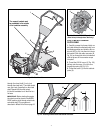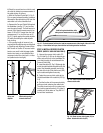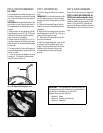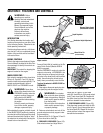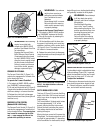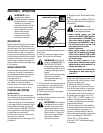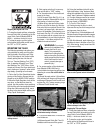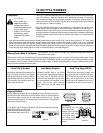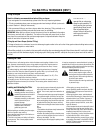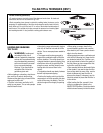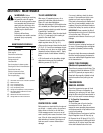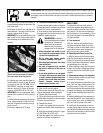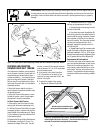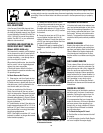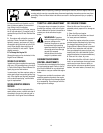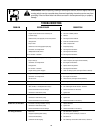
15
Tilling On Slopes
Read the following recommendations before tilling on slopes:
If you must garden on a moderate slope, please follow two very important guidelines:
1. Till only on moderate slopes, never on steep ground where footing is difficult (review safe-
ty rules in Section 1: Safety of this manual).
2. We recommend tilling up and down slopes rather than terracing. Tilling vertically on a
slope allows maximum planting area and also leaves room for cultivating.
IMPORTANT: When tilling on slopes, be sure the correct oil level is maintained in the engine
(check every one-half hour of operation). The incline of the slope will cause the oil to slant
away from its normal level and this can starve engine parts of required lubrication. Keep the
motor oil level at the full point at all times!
Tilling Up and Down Slopes (Vertical Tilling)
• To keep soil erosion to a minimum, be sure to add enough organic matter to the soil so that it has good moisture-holding texture and try
to avoid leaving footprints or wheel marks.
• When tilling vertically, try to make the first pass uphill as the tiller digs more deeply going uphill than it does downhill. In soft soil or weeds,
you may have to lift the handlebars slightly while going uphill. When going downhill, overlap the first pass by about one-half the width of
the tiller.
WARNING:
Do not
operate tiller on a slope too
steep for safe operation. Till
slowly and be sure you have
good footing. Never permit
tiller to freewheel down
slopes. Failure to follow this
warning could result in
personal injury.
The tines have a self-clearing action which eliminates most tangling of debris in the
tines. However, occasionally dry grass, stringy stalks or tough vines may become tan-
gled. Follow these procedures to help avoid tangling and to clean the tines, if neces-
sary.
• To reduce tangling, set the depth regulator deep enough to get maximum “chopping”
action as the tines chop the material against the ground. Also, try to till under crop
residues or cover crops while they are green, moist and tender.
• While tilling, try swaying the handlebars from side to side (about 6" to 12"). This
“fishtailing” action often clears the tines of debris.
• If tangling occurs, lift the tines out of the soil and run the tiller in reverse (if unit is
equipped with powered reverse) for a few feet. This reversing action should unwind a
good deal of debris.
• It may be necessary to remove the debris by hand (a
pocket knife will help you to cut away the material). Be
sure to stop the engine and disconnect the spark plug
wire before clearing the tines by hand.
WARNING:
Before clearing the
tines by hand, stop the engine, allow all
moving parts to stop and disconnect the
spark plug wire. Remove the ignition key
on electric start models.
Failure to follow this warning could result
in personal injury.
Clearing the Tines
Loading and Unloading the Tiller
WARNING:
Loading and
unloading the tiller into a vehicle is
potentially hazardous and we don’t
recommend doing so unless
absolutely necessary, as this could
result in personal injury or
property damage.
However, if you must load or
unload the tiller, follow the
guidelines given next.
• Before loading or unloading, stop the engine,
wait for all parts to stop moving,
disconnect the spark plug wire and let the en-
gine and muffler cool.
• The tiller is too heavy and bulky to lift safely
by one person. Two or more people should
share the load.
• Use sturdy ramps and manually (engine shut
off) roll the tiller into and out of the
vehicle. Two or more people are needed to do
this.
• The ramps must be strong enough to support
the combined weight of the tiller and any han-
dlers. The ramps should provide good traction
to prevent slipping; they should have side rails
to guide the tiller along the ramps; and they
should have a locking device to secure them to
the
vehicle.
• The handlers should wear sturdy footwear that
will help to prevent slipping.
• Position the loading vehicle so that the ramp
angle is as flat as possible (the less incline to
the ramp, the better). Turn the
vehicle’s engine off and apply its parking brake.
• When going up ramps, stand in the
normal operating position and push the tiller
ahead of you. Have a person at each side to
turn the wheels.
• When going down ramps, walk backward
with the tiller following you. Keep alert for any
obstacles behind you. Position a person at
each wheel to control the speed of the tiller.
Never go down ramps tiller-first, as the tiller
could tip forward.
• Place wooden blocks on the downhill side of
the wheels if you need to stop the tiller from
rolling down the ramp. Also, use the blocks to
temporarily keep the tiller in place on the
ramps (if necessary), and to chock the wheels
in place after the tiller is in the vehicle.
• After loading the tiller, prevent it from rolling
by engaging the wheels in the WHEEL DRIVE
position. Chock the wheels with blocks and se-
curely tie the tiller down.
TILLING TIPS & TECHNIQUES (CON’T)



